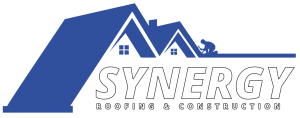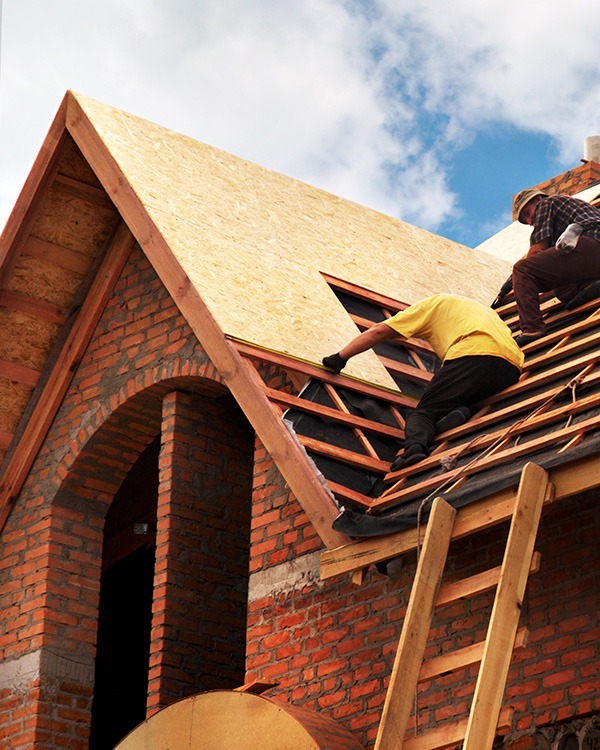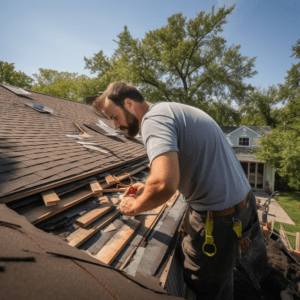Roof repair, an essential aspect of maintaining a structurally sound property, is often accompanied by significant costs. This article aims to explore affordable options for addressing common roof problems and minimizing expenses. By examining signs of roof damage, offering DIY repair tips, discussing the benefits of hiring professional roofing contractors, and considering cost-effective materials as well as financing options, readers will gain practical knowledge on how to approach roof repairs in a manner that optimizes budgetary constraints without compromising quality and long-term solutions.
Key Takeaways
- Regular inspection and maintenance can help identify potential roof problems early on and prevent costly repairs.
- DIY roof repair tips include removing debris, checking for loose or damaged shingles, and using roofing cement or patch kits for temporary fixes.
- When hiring a professional roofing contractor, thorough research and recommendations are important to ensure qualifications and experience.
- Considering cost-effective roofing materials such as metal roofs, clay tiles, and asphalt shingles can balance initial costs with long-term savings.
Common Roof Problems
Common roof problems can be identified through a thorough inspection and analysis of the structural integrity and condition of the roofing materials. One common problem is roof leaks, which can occur due to various reasons such as damaged or missing shingles, deteriorated flashing, or improperly sealed valleys. Another issue is ponding water on flat roofs, often caused by poor drainage systems or improper installation. This can lead to deterioration of the roofing material and eventual leaks. Additionally, blistering and cracking are common problems in asphalt shingle roofs, caused by exposure to extreme temperatures and weather conditions over time.
Age-related wear and tear is another significant concern for many roofs. Over time, roofing materials may deteriorate due to exposure to sunlight, rain, snow, wind, and other environmental factors. This deterioration can result in weakened structural integrity and increased vulnerability to leaks and damage during severe weather events.
Furthermore, inadequate ventilation can cause moisture buildup in attics or under the roof deck which can lead to mold growth and rotting of the underlying structure. Poor ventilation also increases energy costs as it reduces the efficiency of insulation.
Signs of Roof Damage
Evident indicators of damage to a rooftop can include missing shingles, curled or cracked shingles, water stains on the ceiling, and leaks during rainfall. These signs are often indicative of various underlying issues that need to be addressed promptly to prevent further damage. Missing shingles expose the roof’s underlayment to potential water infiltration, which can lead to structural damage if left unattended. Similarly, curled or cracked shingles compromise the roof’s ability to shed water effectively and may result in leaks. Water stains on the ceiling are visible evidence of water penetration through the roof system, highlighting potential weaknesses in its integrity. Leaks during rainfall further confirm the presence of roofing problems that require immediate attention.
It is important for homeowners to be vigilant in identifying these signs as early as possible to mitigate potential damage and avoid costly repairs down the line. Regular visual inspections from both inside and outside the house can help detect these issues early on. Engaging professional roofing contractors for thorough assessments can also provide expert guidance and recommendations for necessary repairs or replacements.
Promptly addressing any identified signs of roof damage will not only preserve the structural integrity of the home but also contribute towards maintaining an affordable roof repair approach by preventing more extensive damages and associated costs.
DIY Roof Repair Tips
One approach to addressing minor roof damage without professional assistance is by implementing simple maintenance practices and utilizing appropriate materials. Regular inspection of the roof can help identify any potential issues early on, allowing for timely repairs. Start by removing any debris such as leaves, branches, or dirt that may have accumulated on the roof surface. This will prevent water from pooling and causing damage. Additionally, check for loose or damaged shingles and replace them as necessary. Use roofing cement to secure loose shingles or seal small cracks in the roof. For larger areas of damage, consider using a patch kit specifically designed for roofing materials like asphalt shingles or metal roofs. These kits typically include adhesive patches that can be applied directly over the damaged area to provide a temporary fix until professional repairs can be made. It is important to note that while these DIY repair tips can address minor issues temporarily, it is always recommended to seek professional assistance for more significant roof damage to ensure proper repairs are made and prevent further complications.
Hiring a Professional Roofing Contractor
A crucial step in the process of hiring a professional roofing contractor is conducting thorough research to assess their qualifications, experience, and reputation within the industry. This research is essential to ensure that you hire a reliable and competent contractor who can provide quality roof repair services. To begin your research, seek recommendations from friends, family members, or colleagues who have recently hired roofing contractors for similar projects. Additionally, consult online platforms such as review websites and professional directories that provide information about local roofing contractors.
When evaluating potential candidates, consider their qualifications. Look for contractors who are licensed, bonded, and insured as this ensures that they meet the necessary legal requirements and can protect you from any liability or financial losses. Furthermore, inquire about their experience in performing roof repairs specifically. A contractor with extensive experience will be more equipped to handle various types of repairs effectively.
Reputation is another crucial factor to consider during the research process. Read online reviews and testimonials from previous clients to gauge the overall satisfaction level with their workmanship and customer service. It may also be helpful to contact references provided by the contractor directly.
Cost-Effective Roofing Materials
Cost-effective roofing materials can be identified by considering their longevity, energy efficiency, and maintenance requirements. When it comes to longevity, metal roofs are considered one of the most durable options available. They have a lifespan of 40-70 years, which is significantly longer than traditional asphalt shingles that typically last around 20-30 years. Metal roofs are also energy-efficient as they reflect heat away from the building, reducing cooling costs during hot weather. Additionally, they can be coated with reflective pigments to further enhance their energy-saving properties.
Another cost-effective roofing material is clay tiles. While they may have a higher upfront cost compared to other materials, their long lifespan of 50-100 years makes them a worthwhile investment in the long run. Clay tiles also provide excellent thermal insulation properties, keeping the interior cool in hot climates and reducing the need for air conditioning.
For those on a budget, asphalt shingles remain a popular choice due to their affordability and ease of installation. While they may not have the same lifespan as metal or clay tiles (typically lasting around 20-30 years), regular maintenance can help extend their durability and performance.
Ultimately, choosing cost-effective roofing materials involves considering factors such as longevity, energy efficiency potential, and maintenance requirements to ensure a wise investment that balances initial costs with long-term savings.
Financing Options for Roof Repairs
This discussion will explore financing options for roof repairs, focusing on three key points: low-interest payment plans, flexible financing options, and no credit check required. Low-interest payment plans allow homeowners to spread out the cost of roof repairs over a longer period of time, reducing the financial burden. Flexible financing options provide homeowners with various repayment terms and structures that can be customized to fit their budget and needs. Additionally, the option of no credit check required ensures that individuals with less than ideal credit scores can still access necessary funds for roof repairs without hindrance.
Low-Interest Payment Plans
Low-interest payment plans offer a viable option for individuals seeking affordable roof repair solutions. These plans allow homeowners to spread the cost of their roof repairs over a longer period, reducing the financial burden of a large upfront payment. By taking advantage of low-interest rates, borrowers can minimize the overall cost of financing their roof repairs. This option is particularly beneficial for those who may not have sufficient savings or immediate access to funds necessary for repairing or replacing their roofs. It enables homeowners to address roofing issues promptly without compromising on quality or safety. Moreover, low-interest payment plans provide flexibility in terms of repayment schedules, allowing individuals to choose a plan that aligns with their budget and financial capabilities. Overall, these plans ensure that necessary roof repairs are within reach for homeowners facing budget constraints.
Flexible Financing Options
In addition to low-interest payment plans, another option for affordable roof repair is flexible financing. This allows homeowners to spread out the cost of repairs over a longer period, making it more manageable within their budget. Flexible financing options may include different repayment terms, such as extended loan periods or deferred payments. These arrangements can provide homeowners with the flexibility they need to address immediate roofing issues without causing undue financial strain. Some companies offer in-house financing, while others partner with third-party lenders to provide these options. It is important for homeowners to carefully review the terms and conditions of any financing agreement before committing to ensure they understand the interest rates, fees, and repayment obligations. By exploring flexible financing options, homeowners can make necessary roof repairs while maintaining financial stability.
No Credit Check Required
No credit check is necessary for homeowners to qualify for flexible financing options, allowing them to address immediate roofing issues without the need for a thorough assessment of their credit history. This feature of flexible financing provides homeowners with the opportunity to obtain roof repair services quickly and conveniently, regardless of their creditworthiness. By eliminating the need for a credit check, homeowners can access affordable roof repair solutions without undergoing a time-consuming approval process that often involves extensive documentation and evaluation of their financial background. Instead, these financing options focus on other factors such as home equity or income stability to determine loan eligibility. This streamlined approach enables homeowners to expedite the repair process and ensure their roofs are promptly fixed, preventing further damage and potential safety hazards.
Preventive Roof Maintenance
This discussion will focus on preventive roof maintenance, specifically highlighting the importance of regular inspections, providing DIY maintenance tips, and explaining how these practices can significantly extend the lifespan of a roof. Regular inspections are crucial for identifying potential issues such as leaks, damaged shingles or flashing, and other signs of wear and tear. Additionally, implementing simple DIY maintenance tasks like cleaning gutters, removing debris, and addressing minor repairs promptly can help prevent larger problems from arising in the future. By prioritizing these preventive measures, homeowners can ensure their roofs remain in optimal condition for an extended period of time.
Importance of Inspections
Conducting regular inspections is crucial for ensuring the integrity and longevity of roofs, particularly in terms of affordability in repair and maintenance. Inspections allow for early detection of any potential issues or damage to the roof, which can prevent them from escalating into more expensive repairs or even complete roof replacement. During an inspection, various factors are assessed, including the condition of shingles, flashing, gutters, and ventilation systems. Additionally, inspectors check for signs of leaks, water damage, mold growth, and structural weaknesses. By identifying these problems early on through inspections, homeowners and building owners can take prompt action to address them before they worsen. Regular inspections also provide an opportunity to identify any required maintenance tasks that can help extend the lifespan of a roof while keeping costs down.
DIY Maintenance Tips
Regular inspections are an essential aspect of roof maintenance, and homeowners can benefit from implementing do-it-yourself (DIY) maintenance tips to ensure the integrity and longevity of their roofs. DIY maintenance not only helps in identifying potential issues early on but also saves money by preventing costly repairs or replacements. One key tip is to regularly clean gutters and downspouts to prevent water buildup, which can lead to leaks and damage. Additionally, inspecting the roof for any signs of damage such as cracked shingles or loose flashing is crucial. It is recommended to replace damaged shingles promptly and secure loose flashing to prevent water penetration. Moreover, trimming overhanging branches can prevent them from falling onto the roof during storms or causing scratches that could compromise its integrity. Implementing these simple maintenance tips can greatly contribute to a well-maintained roof that withstands the test of time.
Extending Roof Lifespan
Implementing preventive measures, such as installing proper insulation and ventilation systems, can significantly contribute to extending the lifespan of a roof. Insulation helps regulate temperature within the attic space, preventing excessive heat buildup in summer and minimizing heat loss during winter. This reduces stress on the roofing materials and prevents premature deterioration. Additionally, proper ventilation allows for the removal of moisture that could lead to mold growth or rotting of wooden components. Adequate airflow also helps prevent ice dam formation in colder climates, reducing the risk of water infiltration under shingles. Regular roof inspections are crucial for identifying any signs of damage or wear early on, allowing for prompt repairs before they escalate into major issues. In conclusion, implementing preventive measures like insulation and ventilation systems combined with regular maintenance can greatly extend the lifespan of a roof.
Long-Term Solutions for Roofing Issues
One approach to addressing roofing issues in a sustainable manner involves exploring long-term solutions that can mitigate the need for frequent repairs. By implementing these solutions, homeowners and building owners can save money and reduce their environmental impact. One such solution is the use of high-quality roofing materials that are durable and resistant to common problems such as leaks, cracks, and damage from extreme weather conditions. Materials such as metal, clay tiles, or slate have been proven to have a longer lifespan compared to traditional asphalt shingles.
Another aspect of long-term roofing solutions is proper installation techniques. Ensuring that roofs are installed correctly by qualified professionals can significantly reduce the risk of future issues. This includes ensuring proper flashing installation around chimneys, vents, and other roof penetrations to prevent water intrusion.
Regular roof maintenance is also crucial in preventing major problems down the line. Conducting regular inspections and addressing minor issues promptly can help extend the lifespan of a roof and avoid costly repairs later on. Regular cleaning of gutters and downspouts is important for proper drainage and preventing water damage.




